An exhibition was held at the Amin Gulgee Gallery in Karachi that featured the work of 40 contemporary Pakistani artists...
The magic of ’70s
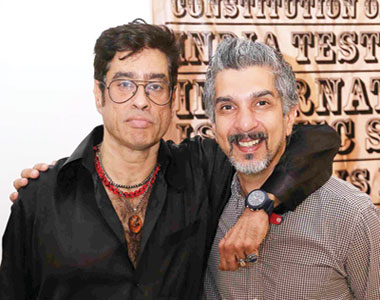
Amin Gulgee with Ameen J
An exhibition was held at the Amin Gulgee Gallery in Karachi that featured the work of 40 contemporary Pakistani artists...
Somehow there is something fascinating about the ‘70s. People who grew up in ‘70s fondly remember the magical era as it was the era of Hippies, Beatles, Bell-bottoms, Rock & Roll, hash etc. Recently, an exhibition that had the whole town enthralled took place at the Amin Gulgee’s gallery.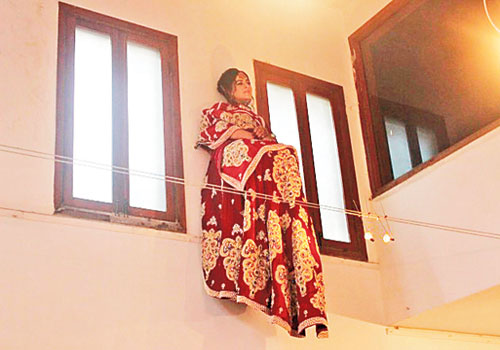
Sarah Pagganwala’s installation of a bride sitting atop a chair elevated in the air
The exhibition titled ‘The ‘70s: Pakistan’s Radioactive Decade’ brought together 40 artists who portrayed what the ‘70s was for them
It was also in the early 1970s that experimentation took place in art, dance, music, television, fashion and advertising. The end of the decade was, however, marked by official censorship - both in the media and a ban on dance on television. Simply put, the era marked the rise and fall of our nation and changed the face of Pakistan forever. To this day a nagging nostalgia remains for those earlier years, and through this exhibition, the artists tried to take us back to the past.
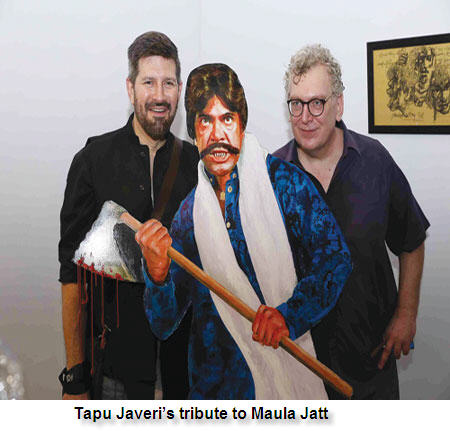
“This show is about what artists think of the ‘70s when the culture was very rich. There used to be workers’ rights movements, activism and freedom. We have tried to show with this exhibition what artists think of [that] era,” said Gulgee. The show comprised video works, drawings, installations, paintings, photography, performance and sculpture. Here’s a look into the show.
The exhibition
The event itself brought in a huge crowd and the premises was completely transformed into the era that was being focused on. On entering the exhibition site, the first artwork to welcome visitors was a live portrayal of the public environment of the ‘70s: two young men, clad in kurta pyjama, sit around a table, smoking, drinking red wine and conversing.
‘Memory Box’ by Omer Wasim was also an interesting installation where the artist had constructed a box using thick concrete walls with one opening. The floor was lit from the edges, with handwritten text on the border of light. The piece had been inspired by the trauma of war that his father had experienced in the ‘70s. Meher Afroz took the theme forward with her work titled ‘Memories from the ‘70s (mixed media) that pointed out the debacle that haunts our collective conscience to date: Pakistan and Bangladesh as two separate geographical entities
Whereas, Adeela Sulaiman’s installation ‘Dance in Your Blood’ showed red disco lights that were also a reference to the war. The question she was asking with her work was, how could a nation thrive even after experiencing so much bloodshed.
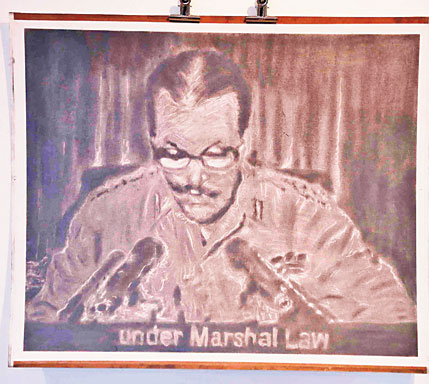
Hasnat Mehmood’s portrait of Zia titled ‘Zinda hai Zia’Apart from war, the exhibit also picked up the ‘dictator’ aspect from the ‘70s. Hasnat Mehmood made a portrait of Zia titled ‘Zinda hai Zia’ and it depicted the dictator reading a ‘script’ as he announced the implementation of Martial Law. Jamil Dehlavi, a noted filmmaker on the other hand had an installation ‘Zuljinaah’ on display from ‘The Blood of Hussain’, a film about a tyrant that was banned during the regime of Ziaul Haq. With the era culminating on Ziaul Haq, many pieces also questioned the long decade that followed and radicalised the future generations.
An interesting scene that instantly captured the attention of viewers was a model in a bridal outfit, sitting atop a chair elevated in the air. The installation by Sarah Pagganwala was a comment on the state of the women who used to be tied into arranged marriages at that time.
The exhibit also had nostalgia parceled in the form of a radio transistor, a black telephone and those red post boxes. These objects added a retro vibe to the whole show. Beenish Mahmood took the theme a step ahead through her video presentation in a piece interestingly called ‘Touch me not Bashirya’. The compilation of black and white snippets (newspaper cuttings, pop songs, film shots, posters etc) enabled the viewer to go down memory lane
Last but not least was a a life size picture of Maula Jatt, the archetypal hero of the ‘70s who ruled Pakistani film industry for more than a decade. Tapu Javeri paid him a tribute using multimedia artwork.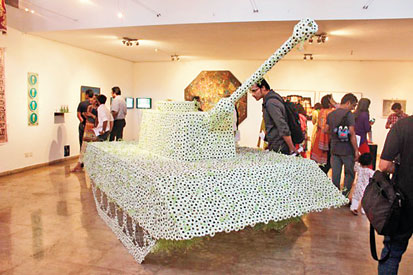
Depiction of war with a tank
Overall, the exhibition was exciting and innovative. Not only did it manage to take people into the past but also made the audience realize the many mistakes we have made as a nation. The show took nine months to be executed and was truly a great look into the incredible era.